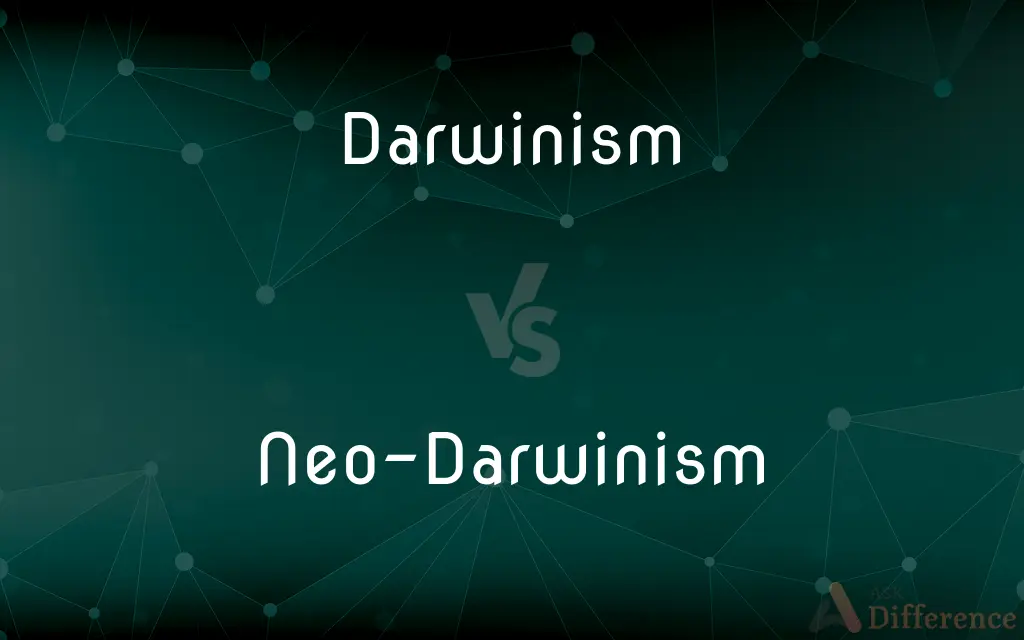Darwinism vs. Neo-Darwinism — What's the Difference?
By Tayyaba Rehman — Published on January 3, 2024
Darwinism focuses on natural selection and survival of the fittest; Neo-Darwinism combines Darwinism with genetics to explain evolution.

Difference Between Darwinism and Neo-Darwinism
Table of Contents
ADVERTISEMENT
Key Differences
Darwinism, based on Charles Darwin's theory, posits that species evolve through natural selection where individuals best adapted to their environment survive and reproduce. This concept emphasized the survival of the fittest in shaping species. Neo-Darwinism, on the other hand, expands upon Darwinism by incorporating modern genetics. It explains how genetic variations occur and are passed to subsequent generations, thus providing a genetic basis for Darwin's ideas.
In Darwinism, variation within a species was acknowledged but not well understood. Darwin suggested that such variations were due to environmental factors and random changes. Neo-Darwinism clarifies that these variations are actually caused by mutations in the genetic material and are inherited. This understanding has deepened the scientific community's knowledge of how evolutionary changes occur over generations.
While Darwinism primarily focused on the gradual change of traits in populations over time, Neo-Darwinism emphasizes the role of genetic drift, gene flow, and mutation in evolution. It provides a more comprehensive framework that integrates various biological fields, including genetics, microbiology, and developmental biology, to explain evolution.
Darwinism laid the groundwork for evolutionary biology, but it lacked the genetic component, as the science of genetics was not developed in Darwin's time. Neo-Darwinism, emerging in the 20th century with the advent of modern genetics, brought a new dimension to evolutionary theory by explaining how genetic variation and natural selection work together.
In summary, Darwinism is foundational in understanding evolution through natural selection, while Neo-Darwinism is an updated version that includes genetic theory to provide a more detailed explanation of evolutionary processes.
ADVERTISEMENT
Comparison Chart
Core Concept
Natural selection and survival of the fittest
Combines Darwinism with genetic theory
Understanding of Variation
Limited, attributed to environment and chance
Genetic mutations and inheritance explained
Genetic Component
Absent, predated modern genetics
Central, incorporates modern genetic science
Focus
Gradual evolution through natural selection
Evolution involving genetic drift, gene flow
Development Time
19th century theory
Emerged in the 20th century with genetics
Compare with Definitions
Darwinism
Darwinism emphasizes survival of the fittest in evolution.
Darwinism was revolutionary in highlighting the role of natural selection in species development.
Neo-Darwinism
Neo-Darwinism integrates genetics with Darwin's theory of evolution.
Neo-Darwinism explains how genetic mutations contribute to the evolution of species.
Darwinism
Darwinism posits that more adapted individuals have better survival chances.
Darwinism suggests that animals best suited to their environment are more likely to survive and reproduce.
Neo-Darwinism
Neo-Darwinism is an updated version of Darwin's original theory.
Neo-Darwinism refines Darwinism by adding a genetic explanation to the process of evolution.
Darwinism
Darwinism is the theory of biological evolution by natural selection.
Darwinism explains how species adapt to their environments over generations.
Neo-Darwinism
Neo-Darwinism includes the study of DNA and genes in evolution.
The discovery of DNA's structure was a pivotal moment in the development of Neo-Darwinism.
Darwinism
Darwinism was developed by Charles Darwin.
Charles Darwin's voyage on the HMS Beagle was crucial in the development of Darwinism.
Neo-Darwinism
Neo-Darwinism emphasizes the role of genetic variation in natural selection.
In Neo-Darwinism, genetic diversity is key to how species adapt and evolve.
Darwinism
Darwinism formed the basis of evolutionary biology.
Darwinism laid the groundwork for our current understanding of how species evolve.
Neo-Darwinism
Neo-Darwinism explains evolutionary changes as a combination of genetic drift, mutation, and natural selection.
Neo-Darwinism provides a comprehensive view of evolution by including genetic drift and mutation.
Darwinism
A theory of biological evolution developed by Charles Darwin and others, stating that all species of organisms have developed from other species, primarily through natural selection. Also called Darwinian theory.
Neo-Darwinism
Darwinism as modified by the findings of modern genetics.
Darwinism
Alternative case form of Darwinism.
Neo-Darwinism
The theory which holds natural selection, as explained by Darwin, to be the chief factor in the evolution of plants and animals, and denies the inheritance of acquired characters; - esp. opposed to Neo-Lamarckism. Weismannism is an example of extreme Neo-Darwinism.
Darwinism
The theory or doctrines put forth by Darwin.
Neo-Darwinism
A modern Darwinian theory that explains new species in terms of genetic mutations
Darwinism
A theory of organic evolution claiming that new species arise and are perpetuated by natural selection
Common Curiosities
What is the main idea of Darwinism?
The main idea of Darwinism is that species evolve through natural selection.
How does Neo-Darwinism differ from Darwinism?
Neo-Darwinism combines Darwinism with modern genetics to explain evolution.
How do genetic mutations fit into Neo-Darwinism?
Genetic mutations create the variations upon which natural selection acts in Neo-Darwinism.
What is natural selection in Darwinism?
Natural selection is the process where individuals better adapted to their environment survive and reproduce.
Is Darwinism still relevant today?
Yes, Darwinism is foundational in evolutionary biology, though it has been expanded upon by Neo-Darwinism.
What role does genetic drift play in Neo-Darwinism?
Genetic drift in Neo-Darwinism refers to random changes in gene frequencies in a population.
What evidence supports Darwinism?
Evidence for Darwinism comes from fossil records, geographical distribution of species, and comparative anatomy.
Did Darwin know about genetics?
No, the field of genetics was developed after Darwin's time.
Was Darwin the first to propose evolution?
No, other theories of evolution existed before Darwin, but his concept of natural selection was unique.
How did Neo-Darwinism change our understanding of evolution?
Neo-Darwinism provided a genetic mechanism for evolution, adding depth to Darwin's original theory.
How does Neo-Darwinism explain species diversity?
Neo-Darwinism explains species diversity as a result of genetic variation and natural selection.
Does Neo-Darwinism incorporate Mendelian genetics?
Yes, Neo-Darwinism incorporates Mendelian genetics, explaining how traits are inherited.
How did Darwinism impact science?
Darwinism fundamentally changed how scientists understand the process of evolution.
Are there any criticisms of Neo-Darwinism?
Yes, some aspects of Neo-Darwinism, like the extent of the role of genetic drift, are debated among scientists.
Can Neo-Darwinism predict evolutionary trends?
Neo-Darwinism can make predictions about evolutionary trends based on genetic and environmental factors.
Share Your Discovery

Previous Comparison
Bhakti Movements vs. Sufi Movements
Next Comparison
new vs. malloc()Author Spotlight
Written by
Tayyaba RehmanTayyaba Rehman is a distinguished writer, currently serving as a primary contributor to askdifference.com. As a researcher in semantics and etymology, Tayyaba's passion for the complexity of languages and their distinctions has found a perfect home on the platform. Tayyaba delves into the intricacies of language, distinguishing between commonly confused words and phrases, thereby providing clarity for readers worldwide.











































